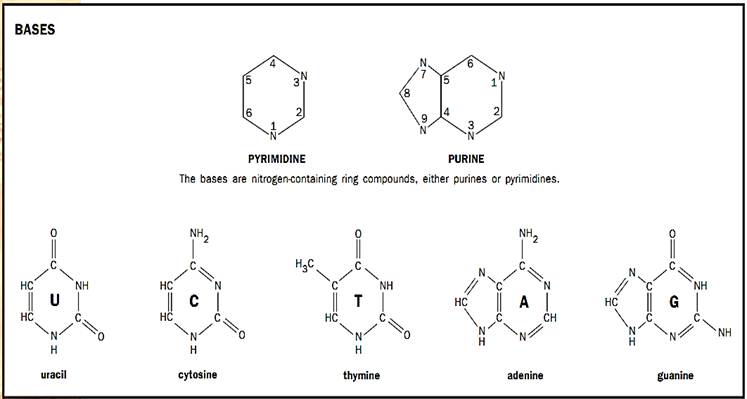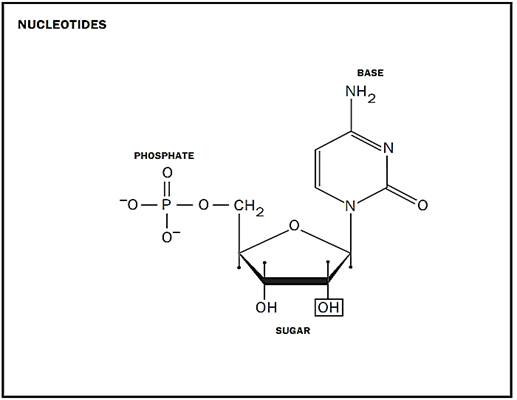


 النبات
النبات
 الحيوان
الحيوان
 الأحياء المجهرية
الأحياء المجهرية
 علم الأمراض
علم الأمراض
 التقانة الإحيائية
التقانة الإحيائية
 التقنية الحيوية المكروبية
التقنية الحيوية المكروبية
 التقنية الحياتية النانوية
التقنية الحياتية النانوية
 علم الأجنة
علم الأجنة
 الأحياء الجزيئي
الأحياء الجزيئي
 علم وظائف الأعضاء
علم وظائف الأعضاء
 الغدد
الغدد
 المضادات الحيوية
المضادات الحيوية|
Read More
Date: 16-10-2015
Date: 15-10-2015
Date: 27-10-2015
|
Nucleotides
Nucleotides are the subunits that are linked to form the nucleic acids ribonucleic acid (RNA) and deoxyribonucleic acid (DNA), which serve as the cell’s storehouse of genetic information. Free nucleotides play important roles in cell signaling and metabolism, serving as convenient and universal carriers of metabolic energy and high-energy electrons.
All nucleotides are composed of three parts: a five-carbon sugar, a phosphate, and a nitrogen-rich structure called a nitrogenous base. The sugar can be ribose, which is found in ribonucleotides and RNA, or deoxyribose, which is found in deoxyribonucleotides and DNA. The only difference between these two sugars is that deoxyribose has one fewer oxygen atom than ribose. The five carbon atoms in the sugar are numbered sequentially. To distinguish these carbon atoms from those of the nitrogenous base, which are also numbered, they are designated as 1' (prime), 2', and so on.
There are five nitrogenous bases. The so-called pyrimidines (cytosine, thymine, and uracil) are smaller, having only one ring structure. The larger purines (adenine and guanine) have two rings. Adenine, guanine, and cytosine are found in both ribonucleotides and deoxyribonucleotides, while thymine occurs only in deoxyribonudeotides and uracil only in ribonucleotides.
The phosphate group is bonded to the 5' carbon of the sugar (see Figure 2), and when nucleotides are joined to form RNA or DNA, the phosphate of one nucleotide is joined to the sugar of the next nucleotide at its 3' carbon, to form the sugar-phosphate backbone of the nucleic acid. In a free nucleotide, there may be one, two, or three phosphate groups attached to the sugar, as a chain of phosphates attached to the 5' carbon.
Three nucleotides merit special consideration because of their specialized roles in cellular function. These are adenosine triphosphate (ATP), flavin adenine dinucleotide (FAD), and nicotinamide adenine dinucleotide (NAD+). Most biosynthetic reactions require energy, which is usually supplied by ATP. When ATP is hydrolyzed to ADP (adenosine diphosphate) or AMP (adenosine monophosphate), energy is released. By coupling this energy release to a reaction requiring energy, that reaction can be made to occur. Since ATP is so frequently used this way, it is commonly called the “energy currency of the cell.”
Adenine-containing molecules are also important coenzymes, serving to carry chemical functional groups that are needed for enzyme activity. Three important adenosine-containing coenzymes are coenzyme A (CoA), FAD, and NAD+. CoA carries acetyl groups into the Krebs cycle (the central metabolic pathway in mitochondria), and FAD and NAD+ carry high-energy electrons from the Krebs cycle to the electron transport system, where their energy is used to synthesize ATP from ADP and inorganic phosphate.
Another adenine-based molecule is important in cellular signaling. When a hormone binds at a cell-surface receptor, it often promotes the production of cyclic AMP (cAMP) inside the cell. In cAMP, the phosphate group is joined to the 3' and 5' carbons of the ribose, forming a small ring structure. cAMP can activate or suppress various cell processes, thereby serving as an intracellular signal and messenger that responds to hormone binding.


Referencesٌ
Nelson, David L., and Michael M. Cox. “Nucleotides and Nucleic Acids.” In Lehninger Principles of Biochemistry, 3rd ed. New York: Worth Publishers, 2000.



|
|
|
|
لصحة القلب والأمعاء.. 8 أطعمة لا غنى عنها
|
|
|
|
|
|
|
حل سحري لخلايا البيروفسكايت الشمسية.. يرفع كفاءتها إلى 26%
|
|
|
|
|
|
|
جامعة الكفيل تحتفي بذكرى ولادة الإمام محمد الجواد (عليه السلام)
|
|
|